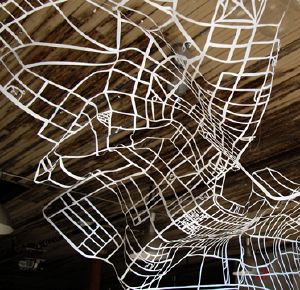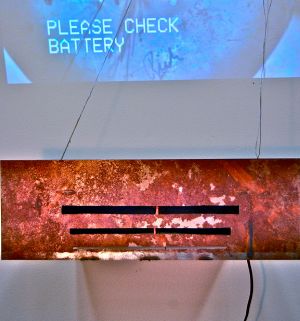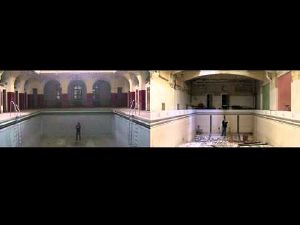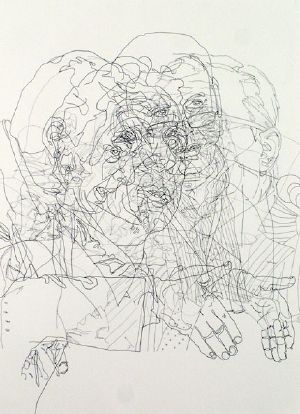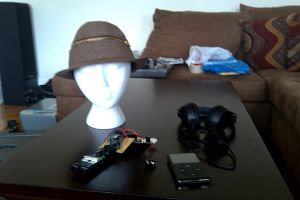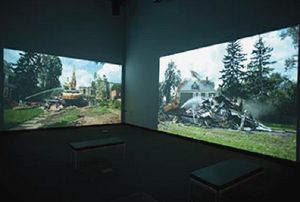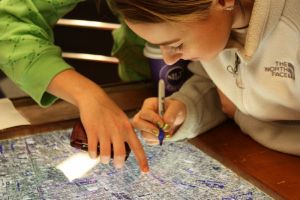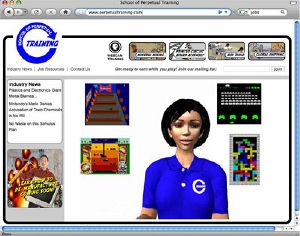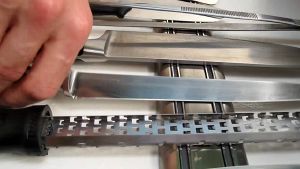| (17 intermediate revisions by the same user not shown) | |||
| Line 16: | Line 16: | ||
Quoted from [http://trustseoul.wordpress.com/trustartists/kim-beom/ TRUSTblog] | Quoted from [http://trustseoul.wordpress.com/trustartists/kim-beom/ TRUSTblog] | ||
== | Kim Beom's work ''Untitled (News)'' was shown at the 51st Biennale in Venice in 2005. | ||
==Katrina Boeming – ''I am telling you a story, home 1996-2006''== | |||
[[Image:Time Mutations - Katarina Boeming - I am telling you a story.jpg|thumb|right|Katarina Boeming – I am telling you a story, home 1996-2006]] | [[Image:Time Mutations - Katarina Boeming - I am telling you a story.jpg|thumb|right|Katarina Boeming – I am telling you a story, home 1996-2006]] | ||
Installation of hand Cut Tyvek and map pins | Installation of hand Cut Tyvek and map pins | ||
My perception of time and space was exercised and altered through memory in several long sittings during the creation of this map. During these sittings I literally cut my passageways through space and time from memory. I simply placed my knife at the starting point of a walk and visualized my movements as my tool traced my footsteps. What you see when looking at the piece is a fictional map of the five boroughs of New York City as they exist in my minds eye. | My perception of time and space was exercised and altered through memory in several long sittings during the creation of this map. During these sittings I literally cut my passageways through space and time from memory. I simply placed my knife at the starting point of a walk and visualized my movements as my tool traced my footsteps. What you see when looking at the piece is a fictional map of the five boroughs of New York City as they exist in my minds eye. | ||
[http://katrinaboemig.tumblr.com/ See artist's website] for more information | |||
<br clear="both" /> | <br clear="both" /> | ||
==Matthias Breuer – ''Reconstructing the Truth''== | ==[[Matthias Breuer]] – ''Reconstructing the Truth''== | ||
[[Image:Reconstructing the Truth.jpg|right|thumb|Matthias Breuer - Reconstructing the Truth]] | [[Image:Reconstructing the Truth.jpg|right|thumb|[[Matthias Breuer]] - Reconstructing the Truth]] | ||
Nowadays reality is a highly constructed body made up of many different ideas, desires and influences. The biggest reality-producing machine, the media with all its different distribution channels, confronts us with a huge colourfulmoving mass made up of countless pictures and sounds. The question about whether what we see is real or not is neither asked nor encouraged. The catchphrase of modernity is see it and believe it, critical discourse is never held. While in ancient times, following Plato's ideas, reality to some is the dancing of shadows on a cave wall, for us it is the interplay of many differently coloured pixels on flat surfaces. Screens are our viewfinders to the world. Our perception is created by artificial interfaces. The connection between reality and man is created by copper wires and silicon plates. A very fragile umbilical cord highly dependent on those who feed it thus holding the ultimate control. | Nowadays reality is a highly constructed body made up of many different ideas, desires and influences. The biggest reality-producing machine, the media with all its different distribution channels, confronts us with a huge colourfulmoving mass made up of countless pictures and sounds. The question about whether what we see is real or not is neither asked nor encouraged. The catchphrase of modernity is see it and believe it, critical discourse is never held. While in ancient times, following Plato's ideas, reality to some is the dancing of shadows on a cave wall, for us it is the interplay of many differently coloured pixels on flat surfaces. Screens are our viewfinders to the world. Our perception is created by artificial interfaces. The connection between reality and man is created by copper wires and silicon plates. A very fragile umbilical cord highly dependent on those who feed it thus holding the ultimate control. | ||
| Line 37: | Line 41: | ||
''underactuation'' is a sculpture/installation that contrasts the measurement and display of time. The face of underactuation displays seconds, minutes, and hours through three horizontal windows. Time is displayed in a linear fashion -- the clock hands appear to move left and right. | ''underactuation'' is a sculpture/installation that contrasts the measurement and display of time. The face of underactuation displays seconds, minutes, and hours through three horizontal windows. Time is displayed in a linear fashion -- the clock hands appear to move left and right. | ||
The video projecting the inside of the steel housing reveals the circular motion of the clock mechanism contrasting with the linear display of the face: problematizing these two | The video projecting the inside of the steel housing reveals the circular motion of the clock mechanism contrasting with the linear display of the face: problematizing these two ''opposing'' ideologies/representations of time as concepts that reveal the potential multitudes of perspective/cosmology. | ||
<br clear="both" /> | |||
==Sofia Dona – ''Twinning Towns: Leipzig—Detroit''== | ==Sofia Dona – ''Twinning Towns: Leipzig—Detroit''== | ||
[[Image:Time Mutations - Sofia Dona - Twinning Towns.jpg|thumb|right|Sofia Dona – Twinning Towns: Leipzig—Detroit]] | [[Image:Time Mutations - Sofia Dona - Twinning Towns.jpg|thumb|right|Sofia Dona – Twinning Towns: Leipzig—Detroit]] | ||
| Line 49: | Line 53: | ||
[http://sofiadona.gr/#3838265717 See artist's website] for more information | [http://sofiadona.gr/#3838265717 See artist's website] for more information | ||
==Angelica Piedrahita Delgado – ''VideoRed''== | |||
[[Image:Time Mutations - Angelica Piedrahita Delgado - VideoRed.jpg|thumb|right|Angelica Piedrahita Delgado – VideoRed]] | |||
[http://www.videored.org ''VideoRed''] is the product of an investigation that seeks the development of a technological device on the internet that invites users to participate with short videos of no more than 15 seconds, that joined together build a video made of fragments as an exquisite corpse. | |||
Video = Vidē = first person of verb see in Latin; linguistic trace that points, since its origins,to the relationship of media to the individual. Video as a subjective practice that on the internet sinks in a totalizing blanket of standardized similarities. Although the differences are complex, when analyzing ''the individual'' as a body that sees in a timeframe within a certain discourse. Narrative and aesthetics practices that cannot be seen outside a unique perception shaped by body, time, and space. | |||
In VideoRed the audiovisual rhetorical figures are connected to each other in the most complex and, at the same time, basic way. A video network apparently connected through a mobile and ambiguous semiotic association, potentially interpreted as a group of empty pieces in search for meaning. Maybe, this is just an associative machine, an ode to interactivity and meaningless playfulness. However, the project focuses on dialogism, as a discourse modality that allows an active sharing of ideas; that can or cant be positioned as structured or vague entities. VideoRed contains videos as microstructures that defeats hermeneutics as others captivated by rhetorical figures. | |||
Beyond defining a true nature of video image, VideoRed intends to allocate video production and interpretation on individuals. Fragmenting, dissecting,connecting, framing, zooming, panning, borrowing and editing are practices that belong to a person that see how understand and understand how perceive. Video is a technological artifact and at the same time is a way to approach and act in front of and object, subject or topic. That is why this project, rather than concentrating its efforts on a technical machine builds its means in gatherings, workshops and communities. Allowing getting closer to other people through video production. Seeing these productions as presence of and author apparently absent but with a strong formal presence, revealing his eye, discourse and body operating the technological artifact. | |||
VideoRed invites to participate in the production of video responses of 15 seconds each. This project is a technological device as a pedagogical practice, product of a research project form Javeriana Univerity at Bogota Colombia. | |||
Since 2009 the group has been organizing gatherings and workshops with people interested on video, that join the project setting rhetorical games and aesthetic explorations. | |||
[http://www.videoredada.blogspot.com/p/time-mutations.html Visit artist's website] for more information | |||
==Carrie Kaser – ''Policy Makers''== | ==Carrie Kaser – ''Policy Makers''== | ||
| Line 59: | Line 79: | ||
<br clear="both" /> | <br clear="both" /> | ||
==Adam Laskowitz – Sound-Portrait== | ==Adam Laskowitz – ''Sound-Portrait''== | ||
[[Image:Time Mutations - Adam Laskowitz - Sound-Portrait.jpg|thumb|right|Adam Laskowitz – Sound-Portrait]] | |||
This work explores the temporal acoustics of the everyday soundscape. By fitting electronics inside of a hat, the wearer exposes themself to a recording of their daily sounds, creating a sound-portrait. The hat records 3 seconds of audio every 20 minutes, in a type of stop-motion fashion. While continuous recording would obviously pick up every sound which the wearer would experience, a disparate capture offers a dense experience of the everyday soundscape. This technique instills a feeling of cyclical temporality during playback. It is both environmental exploration and self-discovery. Leave the hat in one space and hear the cycles of a space, wear the hat for days, weeks, or years and hear the cycles of a life. | This work explores the temporal acoustics of the everyday soundscape. By fitting electronics inside of a hat, the wearer exposes themself to a recording of their daily sounds, creating a sound-portrait. The hat records 3 seconds of audio every 20 minutes, in a type of stop-motion fashion. While continuous recording would obviously pick up every sound which the wearer would experience, a disparate capture offers a dense experience of the everyday soundscape. This technique instills a feeling of cyclical temporality during playback. It is both environmental exploration and self-discovery. Leave the hat in one space and hear the cycles of a space, wear the hat for days, weeks, or years and hear the cycles of a life. | ||
[http://adamlaskowitz.com/ Visit artist's website] for more information | [http://adamlaskowitz.com/ Visit artist's website] for more information | ||
<br clear="both" /> | |||
==Carl Lee – ''Last house''== | ==Carl Lee – ''Last house''== | ||
| Line 85: | Line 107: | ||
==[[Tommy Neuwirth]] – ''Untitled''== | ==[[Tommy Neuwirth]] – ''Untitled''== | ||
[[Image:Time Mutations - Tommy Neuwirth - Untitled.jpg|thumb|right|[[Tommy Neuwirth]] – Untitled.jpg]] | |||
freedom<br /> | |||
"Background images started disappearing when logged in" "Icons started disappearing from Word tool bar" "Paragraphs suddenly started disappearing" "Have '90s songs started disappearing from the radio?" "My eyebrows have suddenly started disappearing." | |||
<br clear="both" /> | |||
==Scott Ries – ''Aceeeh ino rrssstUv''== | ==Scott Ries – ''Aceeeh ino rrssstUv''== | ||
Taking the complete Beatles discography as one track arranged in chronological order (that in which they were released), I divide it into 0.1 sec segments (long enough not to produce a consistent tone, short enough to elude recognition), and then arrange those segments in order of their total energy over each of the 0.1 sec segments, from the least to the most. Each segment's first sample is zeroed at the previous segment's last sample, and the absolute value of its energy pointed towards zero. In other words, I rearrange the familiar Beatles chronology into barely recognizable segments following an entirely different chronology, that of the universe (from least energy to most, or from order to chaos), and point it, futilely, toward equilibrium. The complete track is then re-divided into the exact lengths of each album and track, and is released in the same chronology as were the correspondingly-long Beatles' albums (but could be played in its entirety and transferred easily online for an installation). | Taking the complete Beatles discography as one track arranged in chronological order (that in which they were released), I divide it into 0.1 sec segments (long enough not to produce a consistent tone, short enough to elude recognition), and then arrange those segments in order of their total energy over each of the 0.1 sec segments, from the least to the most. Each segment's first sample is zeroed at the previous segment's last sample, and the absolute value of its energy pointed towards zero. In other words, I rearrange the familiar Beatles chronology into barely recognizable segments following an entirely different chronology, that of the universe (from least energy to most, or from order to chaos), and point it, futilely, toward equilibrium. The complete track is then re-divided into the exact lengths of each album and track, and is released in the same chronology as were the correspondingly-long Beatles' albums (but could be played in its entirety and transferred easily online for an installation). | ||
| Line 90: | Line 117: | ||
==Stephanie Rothenberg – ''School of Perpetual Training''== | ==Stephanie Rothenberg – ''School of Perpetual Training''== | ||
[[Image:Time Mutations - Stephanie Rothenberg - Perpetual.jpg|thumb|right|Stephanie Rothenberg - School of Perpetual Training]] | [[Image:Time Mutations - Stephanie Rothenberg - Perpetual.jpg|thumb|right|Stephanie Rothenberg - School of Perpetual Training]] | ||
School of Perpetual Training is an ironic instructional training program that exposes the underbelly and not so glamorous side of the computer video game industry. Most people associate jobs in the computer video game industry with information-based labor such as 3D graphics and coding game programs. Yet the majority of the industry relies on the sweat and stamina of migrant and low-income laborers working for electronics contract manufacturers in developing countries. | ''School of Perpetual Training'' is an ironic instructional training program that exposes the underbelly and not so glamorous side of the computer video game industry. Most people associate jobs in the computer video game industry with information-based labor such as 3D graphics and coding game programs. Yet the majority of the industry relies on the sweat and stamina of migrant and low-income laborers working for electronics contract manufacturers in developing countries. | ||
By following a series of training exercises, participants learn about the precarious employment and unjust labor conditions of workers in the areas of overseas digital game manufacturing and distribution. A virtual ''personal trainer'' created in Second Life leads participants through a series of training exercises that use motion detection and require full range of body motion to play. Rather than using a mouse or joystick, the motion detection demands the participants ''labor'' to complete the training exercises, emphasizing the extreme physical nature and motion economics of these jobs. The individual training exercises recontextualize popular classic arcade games – Dig Dug, Tapper, Space Invaders and Tetris – in order to ''train'' participants for jobs in mineral mining, printed circuit board assembly, box build and global shipping. At the end of the training program, participants can gauge their ''global market value'' to find out how much they are ''worth'' in contrast to white-collar workers in the industry and game company profits. | By following a series of training exercises, participants learn about the precarious employment and unjust labor conditions of workers in the areas of overseas digital game manufacturing and distribution. A virtual ''personal trainer'' created in Second Life leads participants through a series of training exercises that use motion detection and require full range of body motion to play. Rather than using a mouse or joystick, the motion detection demands the participants ''labor'' to complete the training exercises, emphasizing the extreme physical nature and motion economics of these jobs. The individual training exercises recontextualize popular classic arcade games – Dig Dug, Tapper, Space Invaders and Tetris – in order to ''train'' participants for jobs in mineral mining, printed circuit board assembly, box build and global shipping. At the end of the training program, participants can gauge their ''global market value'' to find out how much they are ''worth'' in contrast to white-collar workers in the industry and game company profits. | ||
[http://www.perpetualtraining.com Try the project online] | [http://www.perpetualtraining.com Try the project online] | ||
==Gabriel Shalom – ''wash choose peel chop rinse''== | |||
[[Image:Time Mutations - Gabriel Shalom - wash choose peel chop rinse.jpg|thumb|right|Gabriel Shalom – wash choose peel chop rinse]] | |||
In the five movements which make up wash choose peel chop rinse, different stages of the process of making vegetable soup stock are examined in microcinematic detail. Rhythmic audiovisual compositions are revealed in the most mundane and subtle aspects of the preparation of various different vegetables. This video was premiered at the opening ceremony of Transmediale 2011, Berlin. | |||
Gabriel Shalom is a videomusician, hypercubist and audiovisual artist living and working in Berlin, Germany. His signature work takes the form of rhythmically edited audiovisual compositions. He has been an artist in residence at the ZKM | Karlsruhe. He is the co-founder, together with [http://pavako.com/ Patrizia Kommerell], of [http://ks12.net/ KS12], a creative studio which produces original transmedia narratives. He has been a guest speaker on audiovisual trends in London, Berlin and São Paulo, and since Spring 2009 he is adjunct faculty at the Berliner Technische Kunsthochschule where he lectures on [http://analogmotiongraphics.com/ analog motion graphics] and experimental film and video. He is a contributor to opinion-leading blogs on the [http://quantumcinema.blogspot.com/ future of cinema] and [http://arsvirtuafoundation.org/research/ augmented reality]. | |||
[http://www.gabrielshalom.com See artist's website] for more information | |||
Latest revision as of 12:17, 5 August 2011
Ana Alenso – Vom Leben für das Leben
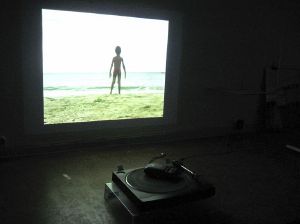
Vom Leben für das Leben was filmed in December 2010 on a beach in Venezuela. The installation is made up of a video projection without audio, a turned on radio receiver placed on a turning record player. The installation tries to rebuild the perception of time from the noise of the radio receiver in a moment that is not only to be understodd as a memento but also as a contemplative and lasting meaning of life.
Visit artist's website for more information
Kim Beom – Untitled (News) (2002)
1-channel video, 1 min 42 sec
Kim Beom explores the formation of new relationships between images and concepts through a wide range of media, including drawings, installations, videos, publications and objects. Particularly concerned with ways of seeing and cognition in relation to sight—the basis of visual art—Kim continuously reveals the tension and conflict between visual perception and false mind. By suggesting images formed on the retina and works that escape from socially normative notions, Kim invites viewers to abandon fixed ideas and contemplate the world from a different perspective.
Untitled (News) is made up of recorded and re-edited cable television news programs. Working from the basic acknowledgement that television programs represent the fundamental synthesis of visual image and spoken language of our age, the artist breaks them down into syllables and fabricates four stories out of the actual accounts delivered by anchorpersons. The text presents an alternative to the mass media, which has a monopoly on informing us of what takes place in the world and on the personal thoughts of individuals accustomed to viewing the reality exclusively through this controlled lens. Kim uses news, which incorporates images and spoken language, as source material in the construction of his own version of news and what he believes is news-worthy. The content of Kim’s news, therefore, reveals the nature of mass media, which selects, edits, translates, and criticizes stories about the world while crossing boundaries between fiction and nonfiction, truth and falsehood, society and individual, and public affairs and daily life.
Quoted from TRUSTblog
Kim Beom's work Untitled (News) was shown at the 51st Biennale in Venice in 2005.
Katrina Boeming – I am telling you a story, home 1996-2006
Installation of hand Cut Tyvek and map pins
My perception of time and space was exercised and altered through memory in several long sittings during the creation of this map. During these sittings I literally cut my passageways through space and time from memory. I simply placed my knife at the starting point of a walk and visualized my movements as my tool traced my footsteps. What you see when looking at the piece is a fictional map of the five boroughs of New York City as they exist in my minds eye.
See artist's website for more information
Matthias Breuer – Reconstructing the Truth
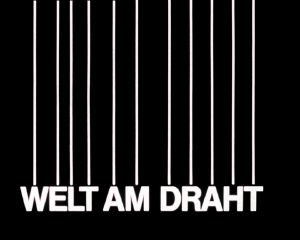
Nowadays reality is a highly constructed body made up of many different ideas, desires and influences. The biggest reality-producing machine, the media with all its different distribution channels, confronts us with a huge colourfulmoving mass made up of countless pictures and sounds. The question about whether what we see is real or not is neither asked nor encouraged. The catchphrase of modernity is see it and believe it, critical discourse is never held. While in ancient times, following Plato's ideas, reality to some is the dancing of shadows on a cave wall, for us it is the interplay of many differently coloured pixels on flat surfaces. Screens are our viewfinders to the world. Our perception is created by artificial interfaces. The connection between reality and man is created by copper wires and silicon plates. A very fragile umbilical cord highly dependent on those who feed it thus holding the ultimate control.
Two movies dealing about the question of what is real, The Matrix (1999) by the Wachowski brothers and World on Wires (1973, orig. title Welt am Draht) by Rainer Werner Fassbinder, are left to the electronic brain of a computer to create, with its countless circuits instructed by a programmer, a reality partly constructed partly real to explore reality and its constructed nature. The outcome is a formal critique of (mass-)media's reality.
Olivier Delrieu-Schulze – Underactuation
steel, cooper, motor mechanism, video camera, projector
underactuation is a sculpture/installation that contrasts the measurement and display of time. The face of underactuation displays seconds, minutes, and hours through three horizontal windows. Time is displayed in a linear fashion -- the clock hands appear to move left and right.
The video projecting the inside of the steel housing reveals the circular motion of the clock mechanism contrasting with the linear display of the face: problematizing these two opposing ideologies/representations of time as concepts that reveal the potential multitudes of perspective/cosmology.
Sofia Dona – Twinning Towns: Leipzig—Detroit
The idea of the project was based on the concept of town twinning (sister cities) whereby towns or cities in geographically and politically distinct areas are paired. The town twinning concept was applied in the cities of Leipzig and Detroit by focusing on the issue of shrinkage and abandonment. Three examples of that connection were realised.
For the first connection a split video was created, with two trombonists playing in two abandoned swimming pools, one in Leipzig and one in Detroit, in a way that the music of both trombonists creates a composition.
The twinning towns: Leipzig -Detroit project consists of different actions that could be seen as actual actions and symbolical actions. Actual actions can be considered moving from one city to another, transporting, installing, removing, playing music, being involved in the city's life, exploring, finding materials and cooperating with musicians, craftsmen and art initiatives. On the other hand the symbolic action is the twinning, the attempt to transform, through the exchange of materials, buildings of Leipzig into buildings of Detroit and the other way around, transforming in a way the one city into the other. Although the actual action, of the specific installations or events, is visible only to a limited audience (the passers buy, the people involved in the project, etc) the symbolic action aims to the larger image and idea of the twinning of two cities, a wider concept opened up to a lot of questions on what the twinning of towns could mean.
See artist's website for more information
Angelica Piedrahita Delgado – VideoRed
VideoRed is the product of an investigation that seeks the development of a technological device on the internet that invites users to participate with short videos of no more than 15 seconds, that joined together build a video made of fragments as an exquisite corpse.
Video = Vidē = first person of verb see in Latin; linguistic trace that points, since its origins,to the relationship of media to the individual. Video as a subjective practice that on the internet sinks in a totalizing blanket of standardized similarities. Although the differences are complex, when analyzing the individual as a body that sees in a timeframe within a certain discourse. Narrative and aesthetics practices that cannot be seen outside a unique perception shaped by body, time, and space.
In VideoRed the audiovisual rhetorical figures are connected to each other in the most complex and, at the same time, basic way. A video network apparently connected through a mobile and ambiguous semiotic association, potentially interpreted as a group of empty pieces in search for meaning. Maybe, this is just an associative machine, an ode to interactivity and meaningless playfulness. However, the project focuses on dialogism, as a discourse modality that allows an active sharing of ideas; that can or cant be positioned as structured or vague entities. VideoRed contains videos as microstructures that defeats hermeneutics as others captivated by rhetorical figures.
Beyond defining a true nature of video image, VideoRed intends to allocate video production and interpretation on individuals. Fragmenting, dissecting,connecting, framing, zooming, panning, borrowing and editing are practices that belong to a person that see how understand and understand how perceive. Video is a technological artifact and at the same time is a way to approach and act in front of and object, subject or topic. That is why this project, rather than concentrating its efforts on a technical machine builds its means in gatherings, workshops and communities. Allowing getting closer to other people through video production. Seeing these productions as presence of and author apparently absent but with a strong formal presence, revealing his eye, discourse and body operating the technological artifact.
VideoRed invites to participate in the production of video responses of 15 seconds each. This project is a technological device as a pedagogical practice, product of a research project form Javeriana Univerity at Bogota Colombia.
Since 2009 the group has been organizing gatherings and workshops with people interested on video, that join the project setting rhetorical games and aesthetic explorations.
Visit artist's website for more information
Carrie Kaser – Policy Makers
Policy Makers, 2010 Ink on Paper 7 Drawings, each 30 X 22 inches
Images and information saturate daily experience. From newspapers, television, and the internet, life in the 21st century is on information overload. SIGNAL/NOISE addresses this overload of information, and my own attempts to make sense of it all. With messages from the media and from advertising combined with expectations on the part of society and family, how can we find our own place in the world anymore? Drawing from media sources, I create layered images that represent my experience with the world of multitasking, compartmentalizing, and juggling it all. My thesis exhibition includes works made from daily drawings based on internet web searches, social media, and news articles. In collecting these traces of popular media and current events, I create a landscape of information. What I hope to reveal is the nature of public interest, the publicity of the personal, and the equilibrium (numbness) that results in over-saturation of information.
Visit artist's website for more information
Adam Laskowitz – Sound-Portrait
This work explores the temporal acoustics of the everyday soundscape. By fitting electronics inside of a hat, the wearer exposes themself to a recording of their daily sounds, creating a sound-portrait. The hat records 3 seconds of audio every 20 minutes, in a type of stop-motion fashion. While continuous recording would obviously pick up every sound which the wearer would experience, a disparate capture offers a dense experience of the everyday soundscape. This technique instills a feeling of cyclical temporality during playback. It is both environmental exploration and self-discovery. Leave the hat in one space and hear the cycles of a space, wear the hat for days, weeks, or years and hear the cycles of a life.
Visit artist's website for more information
Carl Lee – Last house
(2010, 3-channel HD video, stereo sound, 16:30 loop)
When I first moved to Buffalo, NY I was struck by the everyday beauty of the many single-family homes that make up the city. These iconic, turn-of-the-century houses seemed to have endless interpretation. Each structure with its unique details, angles, and arrangements was like a variation on a theme or an instance of an archetype, with its own singular history handed down from deed to deed.
At the same time, Buffalo numbers among the many rust-belt cities dealing with decades-long economic decline and its concomitant depopulation. As a result, vacant and abandoned houses abound. Thousands have been torn down and many more await a similar fate. Empty windows stare out from the last house standing on the block. They wait like a question posed, or a reminder.
If houses are containers for our memories, the structures within which so many minor and major domestic events take place, then each week in this city a collective amnesia grows block by block: a city disappears before our eyes. The demolition of these structures—by design or accident—and the speed, indifference and violence with which it takes place, the transmutations of scale, of space, and even of one's sense of time is breathtaking, tragic, and full of contradictions. Last House is an inquiry, part document, part memorial, into this changing built environment.
See artist's website for more information
Cayden Mak – Buffalo(ve)
Buffalo(ve) is a multimedia collaborative installation. The lightbox is equipped with an unnamed map of the neighborhood around the Crane Branch Library in Buffalo, New York, which library patrons are invited to contribute their own names to. During the course of the installation, a new clear layer on top of the map is added every few days to give more people the opportunity to share and contribute, as well as create a literally layered archaeology of names that local people give to the landscape around them.
Naming is essentially a social practice, and inscribes values and ideas about a place onto the literal physical landscape. A function of conquest, discovery, and historicization, naming places is usually left up to the strongest, history’s winners. However, many places hold secret caches of names — whether they’re what the indigenous people used to call a nearby river, or the name your daughter first gave the grocery store, or a made-up language all your own. Many of these names get lost as people age, die, or move away. Buffalo(ve) is an attempt to preserve some of the hidden, personal, or inscrutable names that we give to our city.
Visit artist's website for full documentation
Tommy Neuwirth – Untitled
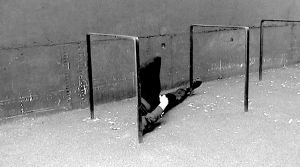
freedom
"Background images started disappearing when logged in" "Icons started disappearing from Word tool bar" "Paragraphs suddenly started disappearing" "Have '90s songs started disappearing from the radio?" "My eyebrows have suddenly started disappearing."
Scott Ries – Aceeeh ino rrssstUv
Taking the complete Beatles discography as one track arranged in chronological order (that in which they were released), I divide it into 0.1 sec segments (long enough not to produce a consistent tone, short enough to elude recognition), and then arrange those segments in order of their total energy over each of the 0.1 sec segments, from the least to the most. Each segment's first sample is zeroed at the previous segment's last sample, and the absolute value of its energy pointed towards zero. In other words, I rearrange the familiar Beatles chronology into barely recognizable segments following an entirely different chronology, that of the universe (from least energy to most, or from order to chaos), and point it, futilely, toward equilibrium. The complete track is then re-divided into the exact lengths of each album and track, and is released in the same chronology as were the correspondingly-long Beatles' albums (but could be played in its entirety and transferred easily online for an installation).
Stephanie Rothenberg – School of Perpetual Training
School of Perpetual Training is an ironic instructional training program that exposes the underbelly and not so glamorous side of the computer video game industry. Most people associate jobs in the computer video game industry with information-based labor such as 3D graphics and coding game programs. Yet the majority of the industry relies on the sweat and stamina of migrant and low-income laborers working for electronics contract manufacturers in developing countries.
By following a series of training exercises, participants learn about the precarious employment and unjust labor conditions of workers in the areas of overseas digital game manufacturing and distribution. A virtual personal trainer created in Second Life leads participants through a series of training exercises that use motion detection and require full range of body motion to play. Rather than using a mouse or joystick, the motion detection demands the participants labor to complete the training exercises, emphasizing the extreme physical nature and motion economics of these jobs. The individual training exercises recontextualize popular classic arcade games – Dig Dug, Tapper, Space Invaders and Tetris – in order to train participants for jobs in mineral mining, printed circuit board assembly, box build and global shipping. At the end of the training program, participants can gauge their global market value to find out how much they are worth in contrast to white-collar workers in the industry and game company profits.
Gabriel Shalom – wash choose peel chop rinse
In the five movements which make up wash choose peel chop rinse, different stages of the process of making vegetable soup stock are examined in microcinematic detail. Rhythmic audiovisual compositions are revealed in the most mundane and subtle aspects of the preparation of various different vegetables. This video was premiered at the opening ceremony of Transmediale 2011, Berlin.
Gabriel Shalom is a videomusician, hypercubist and audiovisual artist living and working in Berlin, Germany. His signature work takes the form of rhythmically edited audiovisual compositions. He has been an artist in residence at the ZKM | Karlsruhe. He is the co-founder, together with Patrizia Kommerell, of KS12, a creative studio which produces original transmedia narratives. He has been a guest speaker on audiovisual trends in London, Berlin and São Paulo, and since Spring 2009 he is adjunct faculty at the Berliner Technische Kunsthochschule where he lectures on analog motion graphics and experimental film and video. He is a contributor to opinion-leading blogs on the future of cinema and augmented reality.
See artist's website for more information

